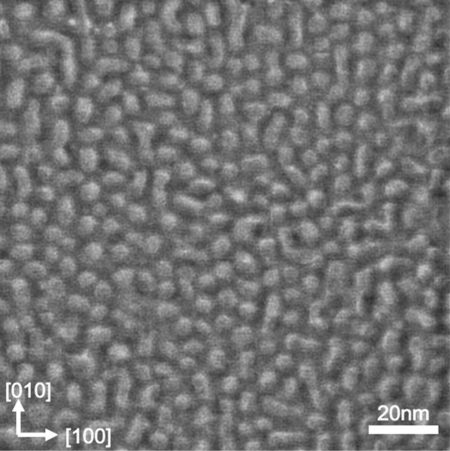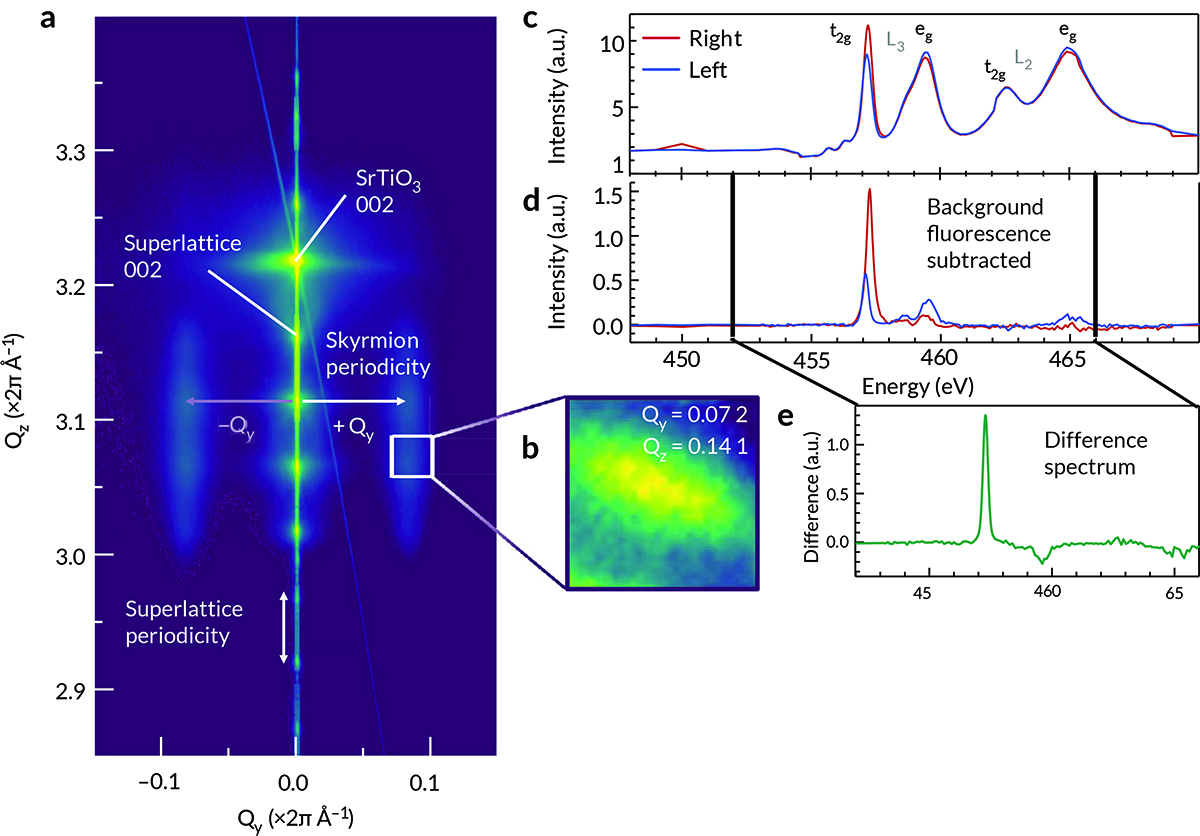SCIENTIFIC ACHIEVEMENT
At the Advanced Light Source (ALS), researchers demonstrated that polar skyrmions—cousins of magnetic skyrmions but comprising swirls of electric dipoles instead of spins—exhibit chirality in a material with electrically switchable properties.
SIGNIFICANCE AND IMPACT
Control of such phenomena could one day lead to low-power, nonvolatile data storage as well as to high-performance computers.
Animation of the calculated structure of a single polar skyrmion. The arrows represent individual electric dipoles in the material, analogous to spins in magnetic skyrmions. The direction of the “equatorial” dipoles through the middle defines the skyrmion’s chirality. (Credit: Xiaoxing Cheng, Pennsylvania State University; C.T. Nelson, Oak Ridge National Laboratory; and Ramamoorthy Ramesh, Berkeley Lab)
Bubbles, bubbles everywhere
A group of researchers, led by scientists from Berkeley Lab’s Materials Sciences Division and UC Berkeley’s Materials Science and Engineering Department, set out to find ways to control how heat moves through materials. They fabricated a material with alternating layers of strontium titanate, which is an electrical insulator, and lead titanate, a ferroelectric material with a natural electrical polarization that can be reversed by the application of an external electric field.
When the group took the material to Berkeley Lab’s Molecular Foundry for atomic-resolution scanning transmission electron microscope (STEM) measurements, however, they found something completely unexpected: bubble-like formations had appeared throughout the material, even at room temperature.
Skyrmions—magnetic and electric

Analysis of the STEM data, combined with theoretical modeling and calculations, suggested that the bubbles were polar skyrmions—electric cousins of the magnetic skyrmions that have been a hot topic of research for a decade now. Whereas magnetic skyrmions are swirls of magnetic spins, polar skyrmions are swirls of electric dipole moments, arising in this case from the displacement of positive and negative charges in a material stressed by mismatched crystal lattices.
Magnetic skyrmions, in addition to being very small (nanometers in scale), exhibit a chirality that can be used to represent binary states. They’re also “topologically protected” features, requiring little energy to maintain. All of this makes magnetic skyrmions attractive as the basis for potentially new forms of high-density, low-power magnetic memory devices. An electrical analogue—polar skyrmions—would be extremely interesting as well, especially in a ferroelectric material, which offers the prospect of controlling skyrmion behavior through external electric fields.
Bubbles with a Bloch belt
In this work, the theoretical calculations and STEM studies together indicated that the polar skyrmions have a Bloch component—i.e., a ring of dipoles circling its “equatorial belt.” Because a similar feature is found in magnetic textures (spin patterns) called “magnetic bubbles,” the researchers dubbed their observed polar-skyrmion textures “polar-skyrmion bubbles.” In contrast to magnetic bubbles, however, the Bloch component here imparts a strict, non-random type of chirality to the polar-skyrmion bubbles, which, in a ferroelectric material, raises the exciting possibility of electric control of chirality. But to fully confirm the chiral nature of these “skyrmion bubbles,” resonant soft x-ray diffraction (RSXD) measurements were needed to capture the full three-dimensional texture.
Shining a light on chirality
RSXD is inherently sensitive to periodic structures such as arrays of skyrmion bubbles, and when using circularly polarized soft x-rays, RSXD is uniquely sensitive to the chiral arrangement of electric dipoles in three dimensions, compared to two-dimensional STEM data. Hard x-ray diffraction studies, performed at the Advanced Photon Source, had revealed two types of periodicities in the material: out-of-plane superlattice peaks and in-plane skyrmion peaks. At ALS Beamline 4.0.2, element-specific circular dichroism difference spectra, taken from the skyrmion peaks, show clear dichroism effects at the titanium edge, confirming chirality.
The researchers next plan on studying the effects of applying electric fields to the polar-skyrmion bubbles and to experiment with skyrmion arrays of the same handedness, to see whether they can be written, moved, and erased. In general, the discovery will no doubt provide fertile ground for exploring new physics and applications.

Contact: Ramamoorthy Ramesh
Researchers: S. Das, M.R. McCarter, S. Saremi, and B. Prasad (Univ. of California, Berkeley); Y.L. Tang, S.-L. Hsu, L.W. Martin, and R. Ramesh (Univ. of California, Berkeley, and Berkeley Lab); Z. Hong, V.A. Stoica, B. Wang, and L.Q. Chen (Pennsylvania State University); M.A.P. Gonçalves (Luxembourg Institute of Science and Technology); C. Klewe, P. Shafer, and E. Arenholz (ALS); K.X. Nguyen, A.B. Mei, D.G. Schlom, and D.A. Muller (Cornell University); F. Gómez-Ortiz, P. García-Fernández, and J. Junquera (Universidad de Cantabria, Spain); C. Ophus and J.F. Liu (Berkeley Lab); C.T. Nelson (Oak Ridge National Laboratory); and J. Íñiguez (Luxembourg Institute of Science and Technology, Univ. of Luxembourg).
Funding: Gordon and Betty Moore Foundation; Army Research Office; U.S. Department of Energy, Office of Science, Basic Energy Sciences Program (DOE BES); National Science Foundation; Luxembourg National Research Fund; Spanish Ministry of Economy and Competitiveness; and Spanish Ministry of Science, Innovation and Universities. Operation of the ALS is supported by DOE BES.
Publication: S. Das, Y.L. Tang, Z. Hong, M.A.P. Gonçalves, M.R. McCarter, C. Klewe, K.X. Nguyen, F. Gómez-Ortiz, P. Shafer, E. Arenholz, V.A. Stoica, S.-L. Hsu, B. Wang, C. Ophus, J.F. Liu, C.T. Nelson, S. Saremi, B. Prasad, A.B. Mei, D.G. Schlom, J. Íñiguez, P. García-Fernández, D.A. Muller, L.Q. Chen, J. Junquera, L.W. Martin, and R. Ramesh, “Observation of room-temperature polar skyrmions,” Nature 568, 368 (2019), doi:10.1038/s41586-019-1092-8.
Adapted from the Berkeley Lab news release, “Electric Skyrmions Charge Ahead for Next-Generation Data Storage.”
ALS SCIENCE HIGHLIGHT #398